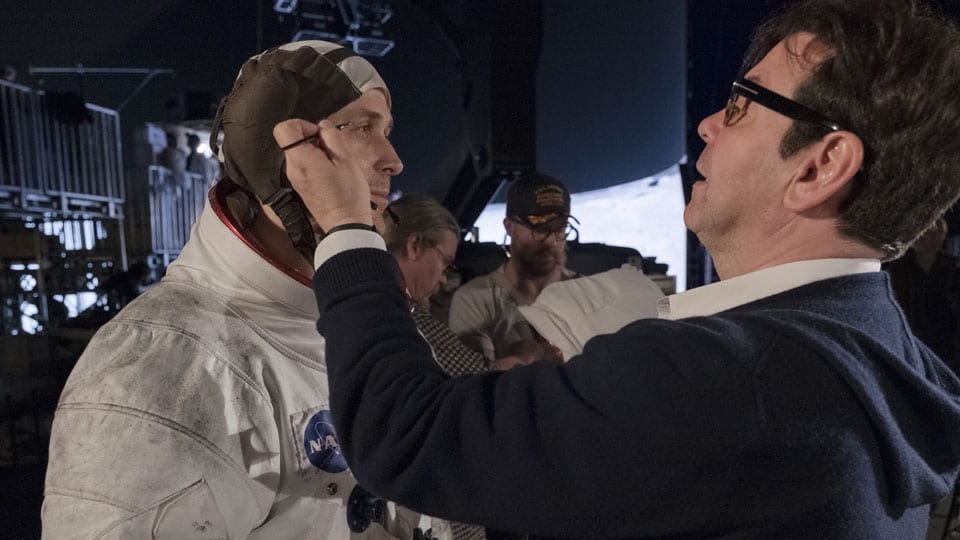By Mark London Williams
When someone applies the phrase “aestheticbattle” to The Simpsons, one might think it’s a line cooked up by Lisa,bemoaning her fate as a vegetarian jazzbeaux consigned to Springfield’s– and America’s – first family of convivial dysfunction.
But it’snot a line from a script at all, instead being an observation by sounddesigner Christopher Scarabosio, on the sensibilities he had to balancewhen translating the sound of a beloved TV series, with its 18 seasonsof familiarity, to the big screen. It was “kind of a battle,” he says,”but not in a bad way.”
That good battle he refers to is the factthat the Simpson filmmakers – director David Silverman,producer/writers James L. Brooks, Matt Groening, Al Jean, producerRichard Sakai, and others comprising the show’s brain trust – “wantedit to sound as much like a movie as possible.”
Of that collective,”they’ve obviously worked together and argued – in a good way! – to getwhere they are.” And where they are is at the end of two decades –anentire generation—of overseeing the most successful sitcom in thehistory of American television.
Thus, the film’s audience hasalready spent a generation getting used to how the Simpsons – andeverything in their yellow-hued animated world – is supposed to sound.
And that’s not always the same way a movie sounds. In fact, usually it’s not.
Scarabosiois based at ILM, and his pedigree of aural expertise includesadditional sound design on the last Pirates of the Caribbeaninstallment, sound effects editing on Munich, stints on Eragon, thelast Ice Age and Hellboy, and, as one might guess, some Star Wars timeas well, as dialogue editor on Revenge of the Sith, and the alwayscolorful “sound fu” credit on Attack of the Clones.
In the Star Warsfilm, he notes the range of sounds fall within “set parameters – youknow what you’re getting.” There are light sabers, and explosions, andthe foot-fall of Imperial storm troopers landing on planet surfaces,etc.
But in the land of the Kwik-E-Mart, things are different:”The Simpsons’ universe is pretty irreverent – you have a creature withtwenty eyes, and you have a skateboard.”
And yet, even the prosaicsounds, like the skateboard – never mind what a 20-eyed squirrel is”supposed” to sound like – didn’t come as easily as, well, as easily asHomer’s appetite for donuts, say.
In some ways, in fact, thesquirrel was easier to concoct – it was voiced by Dan Castellaneta,who, of course, famously vocalizes for Homer, Krusty, and several otherSimpsons regulars, with “animal sounds” worked into the mix.
But forthe “normal” or seemingly prosaic sounds of the Simpsons universe,”there’s definitely an aesthetic – it’s either right or wrong.” Meaningit just works – or it doesn’t.
“They definitely have a guerrillastyle,” Scarabosio allows. “I’d throw stuff up there (thinking) ‘I knowa sound I can use.” And in the end, it just wasn’t “right.”
So, like Supreme Court justices on pornography, the Simpsons’ brain trust knew the right sound when they saw it. Or heard it.
Evenwhen they were fooling around with physics. Some things at first seemedlike they were “going to be kind of easy in some ways,” Scarabosiosays, citing, for example, the glass dome the government uses to sealoff Springfield – and which later develops ominous cracks. “Glass wantsto shatter,” he says, “but it doesn’t want to crack.”
At least,not extensively, before giving way. Still, when the story calls forextended cracking, it still has to sound, well, “right.”
And inthis instance, “the right sound “isn’t always the most impressivesound.” Nor can it get in the way of the words. In the Simpsons’ world,the creators are “very protective of dialogue.”
So he “came up witha bunch of new stuff” for the dome scene, going beyond a lot of thelibrary sounds he’d originally thought he could use. Added to the mixin the scene was “the bomb suitcase bouncing around (the top of) thedome – I spent a fair amount of time getting the right sound for that.”
Asfor the aforementioned “guerrilla style,” it even extended toscheduling: He’d originally planned to start with temp mixes on thefilm in January of this year, figuring that’d be tight enough for asummer release. Then he got a call saying “we’re not gonna start ‘tilmid-April.”
Left both surprised and mix-less, he “looked for otherwork,” but ILM being ILM, he didn’t have to look far, and thus wound uphelping on Pirates.
“Then they called back,” he notes, and theywere back on the original schedule, which included “four temp mixes(making) for no surprises in the final mix.” In fact, they’d begin thetemp tracks “from pencil sketch stuff” as the film was being made – oris that “built?”
As for the tools, Scarabosio notes he “reallylikes ProTools (for) getting a lot of stuff premixed (and) sending itto the console for the final mix.”
And on ILM itself, he waxesgrateful about it, much as Homer does – in one of his more lucidmoments – about his own family: “We have a great support system,” hesays.
That support system will steer him through his next bigproject, working on director Paul Thomas Anderson’s There Will BeBlood.
No indication yet if there are any scenes involving either20-eyed squirrels, or Harleys being driven around town-sized glassdomes.
Written by Mark London Williams





